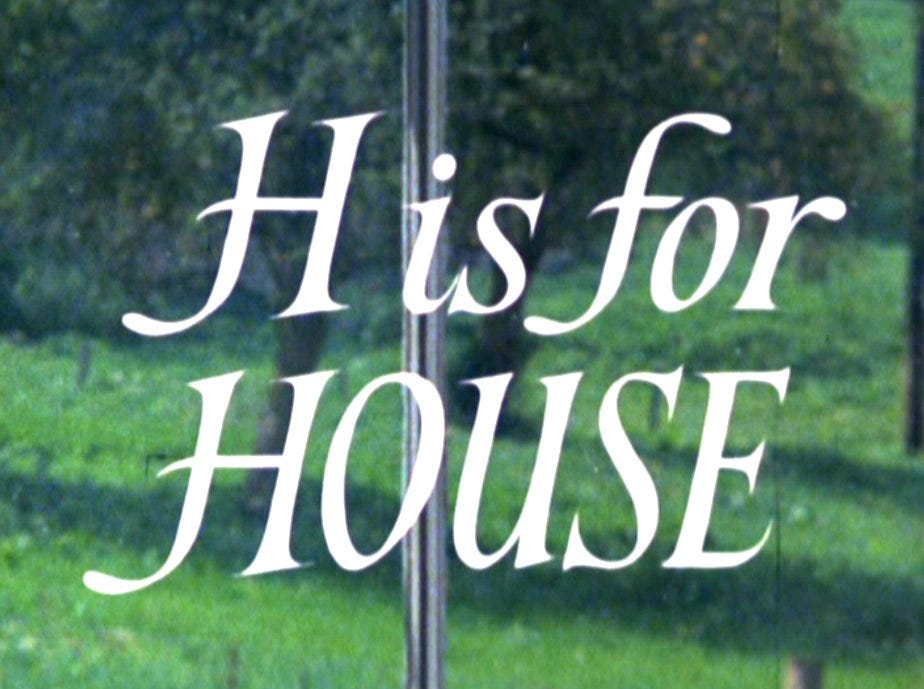◡◶▿ HOME09 | Set & sequence
🗂️ Chronology is corny. Reconstructing the ruins of your home life. Plus: Christmas with the Brakhages. | Renovating the Home Motion Picture Week 9
Okay. We made it over “darkness’s hump day.”1 In this hemisphere, anyway! And to week nine of our program on “what the incidental home moviemaker can teach the dedicated amateur and the industry professional. And vice versa.”
So, let’s pan back to last week’s lesson, Hobby horses. We learned how:
The word “hobby” comes to us from the hobby horse: a broompole pony “pretend-ridden and maintained for pleasure.”
The filmmaker who wishes to channel the energy of the pure hobbyist may pet and groom her tools as a child doth their hobby horse.
Filmmakers like Gustav Deutsch and Carolee Schneemann devised elaborate shot framing techniques and technologies for their home movies…
… as did Tony Hill, who emerged from his garage with a special satellite crane that slices right through space and time.
Missed a week? Joined late? Don’t worry about reading these lessons out of order. Each functions independently. They are sent in a sensible sequence but hardly reliant on it.
Okay. We’re in the final two weeks of our Renovating the Home Motion Picture series. Better take a look at editing. And how:
🥱 It’s hard keeping the home movie fresh when the sound stage of your life gets stale.
🗂️ One way to look at your home footage anew is to remove the chronology and order your clips by category.
🏠 Peter Greenaway’s category of choice? The letter “H.”
🏖️ Meanwhile, Gustav Deutsch attempted to order everybody’s footage by category - and lost the home movies’ homeliness altogether!
By the way, if you are annoyed by emails from Substack saying things like “Graeme Cole posted new notes,” you can scroll to the bottom of them to unsubscribe from those notifications. Could be good. But never, ever click on Unsubscribe in an email from me. Like this one. Never!
You could click Share instead. ‘Tis the season:
Read on. Perhaps with a mince pie.
Set and sequence
You can hear me deliver this lesson by scrolling up to the header and clicking Listen and/or the play ▸ button.
“For me, the sketches I produce now and then are shortish or longish chapters of a novel. The novel I am constantly writing is always the same one, and it might be described as a variously sliced-up or torn-apart book of myself.” - Robert Walser
The home moviemaker might soon tire of her home interior and garden as a film set. Too many samey sequels! The home movie hobby became a house movie industry. A domestic franchise.
Of course, the filmmaker can make home movies elsewhere (on holiday, at weddings). But the problem remains the same. A family holiday is always the same place. Every wedding, too. Still, there are things to be filmed, in the house, on the beach, at the hall. So, how to keep that home movie fresh?
One way is to structure household footage as variations on a theme rather than a musty progression through time. A set rather than a sequence.
Birthday reels occupy this niche rather casually. The filmmaker-parent who digs out her Super 8 camera only for birthdays soon has a cycle of evolving rituals on film. Organised by the unique rhythm of the family birthday calendar. No editing required; non-edited in camera.
This rhythm can be powerful. A unique fingerprint for each family. Evident from the regular leap between seasons and growth spurts.
However, the overarching chronological structure burdens the birthday reel. Chronology is corny.
The filmmaker may better achieve a satisfying “set” structure for her home movie through editing. Chopping and sorting her accumulated moments. Better to break down that birthday reel into its component parts (candle-blowing, tears, etc.). And re-order them according to some other metric (luminosity, distance between camera and subject, passion, etc.).
Peter Greenaway arranged his home movie footage to fit the category of Things that begin with H. Or occasional other letters. Forcing him to illustrate his H-words with loose associations from around the home and neighbouring woodlands. Choosing and reusing images from his “casual” home movie practice.
“The alphabetical index is an extremely primitive way of organising information, and in some ways is totally absurdist,” says Greenaway. “H is for Hitchcock, but also H is for home movie.” Footage accumulates and echoes according to a hyperlogic that resists reverse engineering. There is a system. But there is also a Dad.
When the filmmaker arranges her home movie like this, she becomes aware of the delicate balance between the personal/particular and the general/mundane. She might lose her humility if she veers from the particular. If she untethers the stuff of her home movie from its context. Its soil, its humus. There is a point at which it becomes “impossible to see the trees for the forest.” Sad to lose those trees.2
This happened to Gustav Deutsch. Deutsch applied the set structure to the holiday movies of others. Sorting and editing their clips by image detail and camera movement. Deutsch writes that, in Adria Holiday Films 1954-68 (The School of Seeing I) (1990), “the private depiction of an individual situation becomes a document of a general situation.” In doing so, the films reject their status as a home movie and become a mere documentary.
Adria’s audience - or the pupils of Deutsch’s School of Seeing - soon find themselves searching for human contact, human particularity. To discover that every Dad films every column the same way (or rather with one of three common camera moves) is far less interesting than to be reminded that everybody responds to being filmed in their beachwear the same way.
The differences between families become the same. The groove of multiple Dads’ horizontal pans across the waves feels inevitable; a cosmic repetition. The generality of the cosmos.
But to dwell on the same Dad’s eternal camera move a dozen times, or its waves, is to dig down into the family humus.
A lifetime of one family’s holiday movies as stacked sets: first the columns, then the strongman poses, etc. A supercut of Madame Ernaux’s meaningful glances to the middle distance. You might imagine a different set of truths will emerge. And a different set of deceits. Patterns of behaviour, patterns of shooting and not-shooting, patterns of swimwear.
Later, Deutsch attempted something more particular. He set categories for the actual filming of his own home movies. His “pocket movies.” Set pans or looking styles or topics of interest. Categorised before they were even shot.
But this determined camera lacked humbleness. It’s one thing to mulch your life’s footage, and another to set out with pre-mulched conceptions.
“I’m strewing numerous fragile mirrors on my path, which eventually shatter and carry along fragments of myself, collected and reconstructed by someone, somewhere, one day.” - Boris Lehman
Please share your thoughts, queries, and exercises from this week’s lesson in the comments.
‘Tis the season to dip your raw stock in acid
It’s Christmas this week, for some people. And for everyone else, as well! That seems to be how it goes.
Alex Fields has curated a list of avant-garde Christmas movies. You may recognise some of your favourite characters from this term at Unfound Peoples Videotechnic. Great! Super-relevant.
Unseen home movies of James Bond
Unseen home movies of James Bond!
And Merry Whatever The Hell This Is, if you celebrate:
It’s expanded, but it ain’t cinema!
See you back in school next Monday for the last class of term. “No rest for the wicked.” We’re going to talk about silence in home movies. Finally!
Class dismissed,
~Graeme Cole.
(Principal)
📹 Unfound Peoples Videotechnic | Cloud-based filmmaking thought. ☁️
🦋 Bluesky | 🐦 Twitter | 📸 Instagram | 😐 Facebook | 🎞️ Letterboxd | ⏰ TikTok |🌐 unfound.video
Winter solstice. I’m talking about the winter solstice.
Greenaway’s film pushes particularity to its limits; any more repetition and the family’s charm might get swallowed up. At the same time, this is kind of the point of the film - to pit categories against their contents, sets of things against each thing that makes up the set.







